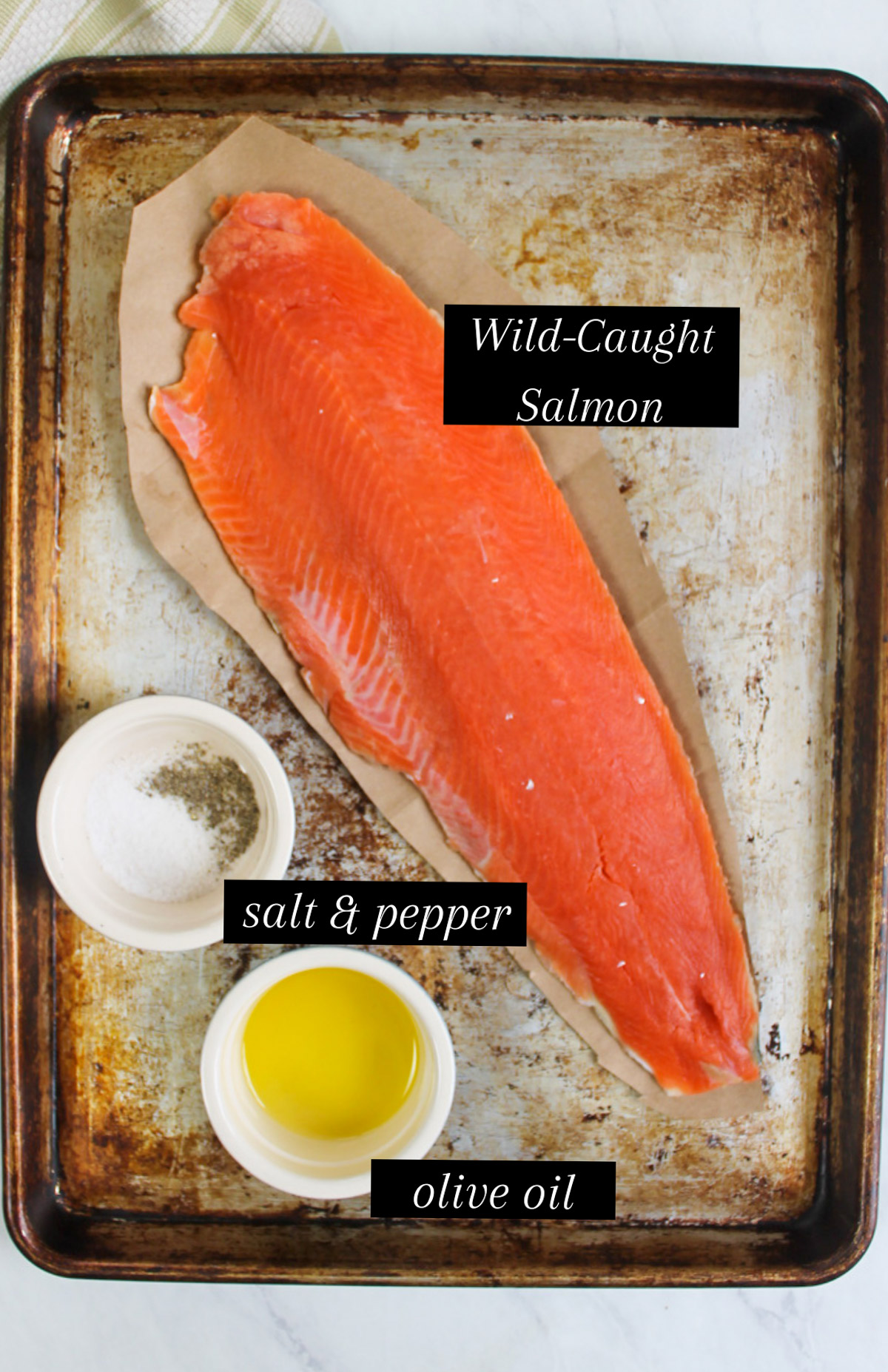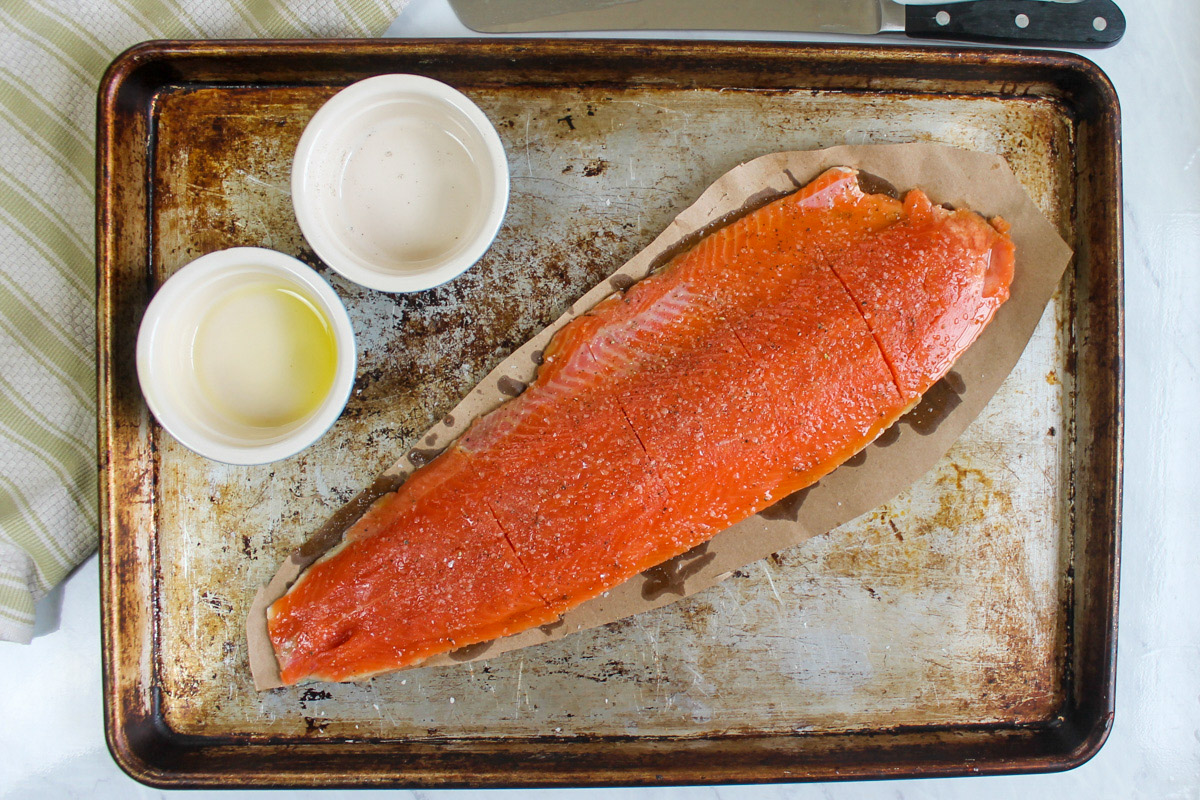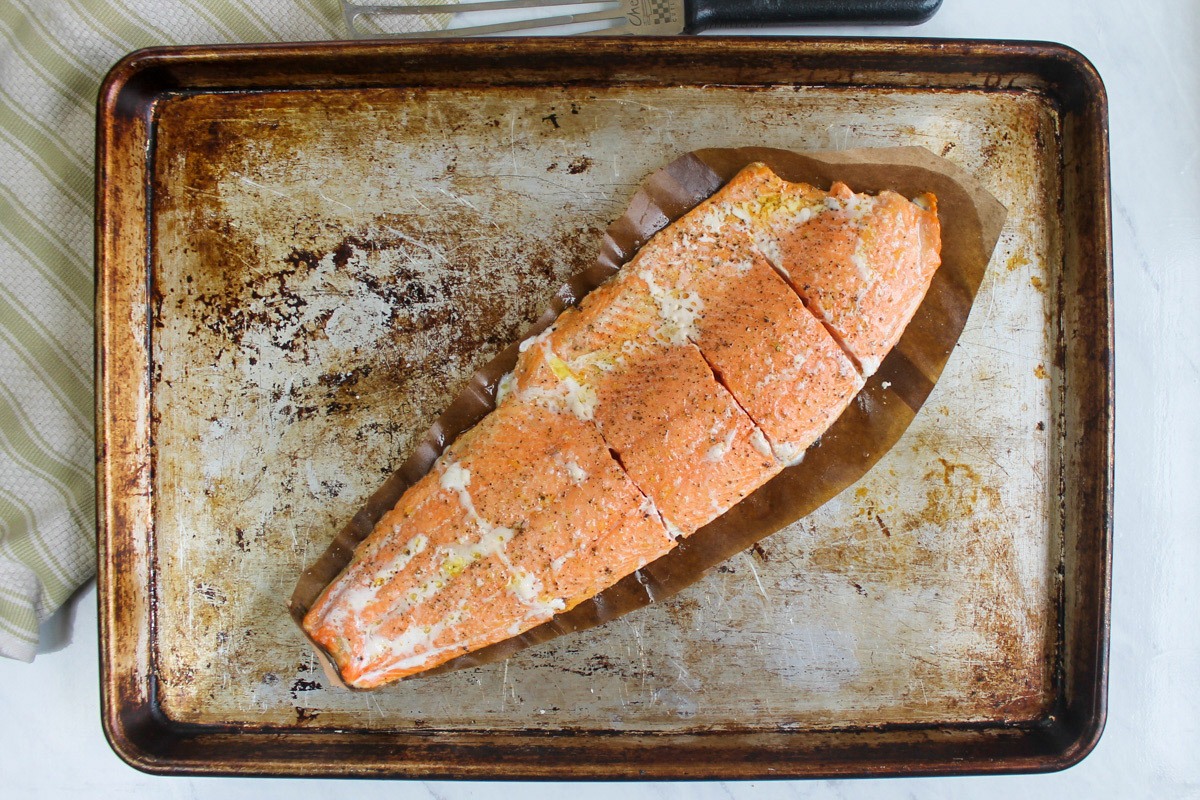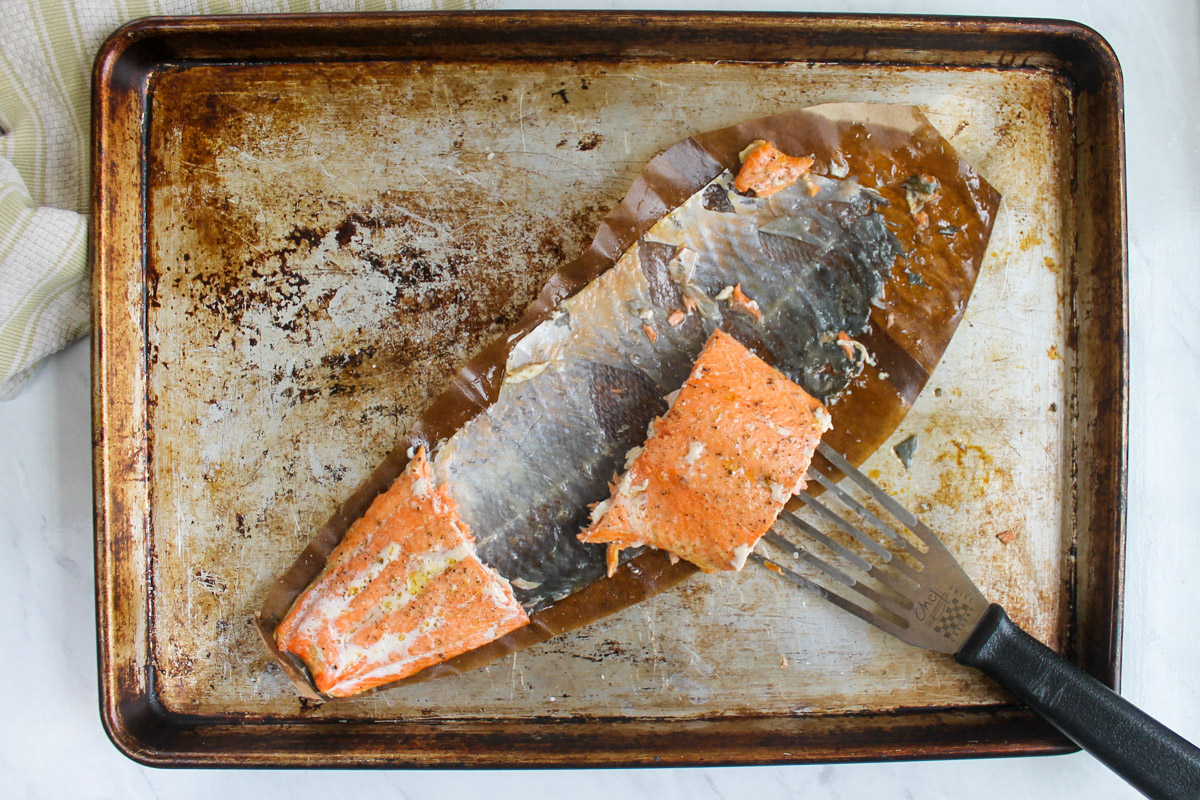This Easy Roasted Wild-Caught Salmon is the best basic way to always cook salmon perfectly! Topped with just olive oil, salt, and pepper, the salmon’s quality shines through and goes well with any side dish. Quick and easy, and it’s ready in 20 minutes! Great for a fancy dinner or a night in during the week.
In terms of health and taste, wild-caught salmon is one of the best fish you can eat. Salmon should be a regular part of a healthy diet because it is full of protein, vitamins, minerals, and omega-3 fatty acids that are good for your heart.
To enjoy wild-caught salmon, you need to know how to cook it so that it always comes out moist, flaky, and full of flavor. Follow these simple tips and techniques for cooking wild salmon flawlessly.
Choosing Your Salmon
Wild caught salmon offers superior flavor and nutrition compared to farmed salmon. It lives in the wild, eating its natural diet and swimming upstream to spawn. Farm-raised salmon are kept in pens, fed an artificial diet and treated with antibiotics
The most common wild salmon varieties are:
-
Sockeye salmon – Also called red salmon, this variety has bright orange-red flesh and a robust flavor. It has the highest omega-3 content of all salmon.
-
Coho salmon – With silver skin and pink flesh, coho salmon has a mild flavor and medium-firm texture. It’s a nice option forcooking multiple ways.
-
King salmon – The largest salmon species king salmon has high fat content, giving it a buttery flavor and silky texture when cooked. It’s a treat for special occasions.
-
Pink salmon – A smaller fish with light pink flesh, pink salmon has a delicate flavor that’s easy for kids. It’s often canned.
No matter which type you choose, look for fresh wild salmon in season from May to October Frozen wild salmon can be used any time Avoid pale “Atlantic” salmon, as it’s farm-raised.
Simple Roasted Salmon
Roasting is one of the easiest cooking methods for salmon fillets. The high heat of the oven quickly cooks the fish while keeping it moist inside.
-
Pre-heat your oven to 400°F. Line a rimmed baking sheet with parchment paper.
-
Place 4-6 oz salmon fillets skin-side down on the pan. Brush lightly with olive oil and season with salt and pepper.
-
Roast for 10-15 minutes based on thickness. Check for doneness after 10 minutes. The salmon should flake easily and be lightly pink inside when done.
-
Let rest for 5 minutes before serving. The salmon will continue cooking as it rests.
Roasting brings out salmon’s natural flavors beautifully. You can also top the fish with citrus slices, fresh herbs or compound butter before cooking.
Pan-Seared Salmon
Pan-searing is a quick, high-heat method to get a crispy exterior on salmon fillets while leaving the inside tender and juicy.
-
Pat salmon fillets dry and season both sides with salt and pepper.
-
Heat 1 Tbsp olive oil in a skillet over medium-high heat. When hot, add salmon skin-side up.
-
Cook 2-3 minutes per side. Reduce heat if pan starts smoking. Salmon is done when it flakes easily with a fork.
-
Serve salmon fillets with pan juices drizzled on top.
Using a non-stick pan prevents the salmon from sticking. You can also use butter or a neutral oil like avocado or grapeseed oil to sear the fish.
Poached Salmon
Poaching gently cooks salmon in hot, not boiling, liquid. This moist method keeps the salmon tender and silky without overcooking.
-
Add 3 cups water, 1 cup white wine, lemon slices, parsley and other aromatics to a skillet. Bring to a simmer.
-
Season salmon fillets with salt and slowly submerge in liquid. Cover and cook at low simmer for 5-10 minutes based on thickness.
-
Salmon should flake easily when done. Be careful not to overcook.
-
Serve poached salmon warm with the poaching liquid or chill in the liquid and serve cold.
Poaching liquid can be broth, wine, citrus juice or water. Keep the temperature right below boiling to poach salmon perfectly.
Baked Salmon in Foil
Baking salmon in parchment paper or foil packets seals in moisture and flavors. Subtly seasoning the packets allows the salmon flavor to shine.
-
Cut 4 large squares of parchment paper. Place 4 oz salmon, sliced lemons, thyme sprigs, salt and pepper on each.
-
Fold paper over salmon tightly and twist ends to seal. Place packets on a baking sheet.
-
Bake at 400°F for 10-15 minutes until salmon is cooked through. Open packets carefully to avoid steam.
Foil or parchment paper packets can also include veggies, rice or potatoes for easy baked salmon meals. Use caution when opening the hot steam.
Grilled Salmon
Grilling salmon over direct high heat creates a smoky, charred exterior. Be careful not to overcook the fish.
-
Coat skin-on salmon fillets with olive oil and season with salt and pepper.
-
Preheat grill on high. Clean and lightly oil the grates.
-
Place salmon on grill skin-side down. Cover grill and cook 3-5 minutes per side with lid down.
-
Salmon is done when it starts flaking and is slightly translucent in center. Don’t overcook.
-
Use a thin spatula to flip salmon instead of tongs to keep it intact.
Grilling salmon without the skin can cause it to stick and fall apart. Use a hot, well-oiled grill and don’t move the fish once placed.
Broiled Salmon
Broiling cooks salmon quickly under direct overhead high heat. Keep a close eye to prevent burning.
-
Place oven rack 6 inches from heat source. Preheat broiler on high.
-
Line a baking sheet with foil and coat with oil. Place salmon skin-side down on pan.
-
Broil for 8-12 minutes based on thickness. Check often to avoid burning.
-
Salmon is done when it starts flaking and is still moist inside. Don’t overcook.
Broiling can dry out salmon if cooked too long. Watch it closely and remove it as soon as the inner color changes from translucent to opaque.
Slow Roasted Salmon
Low, slow roasting gently cooks salmon while keeping it amazingly moist and tender. It takes patience but yields incredible results.
-
Preheat oven to 250°F. Line a baking sheet with parchment paper.
-
Place salmon fillet on sheet. Lightly coat with olive oil and season with salt and pepper.
-
Roast for 20-30 minutes until fish is lightly pink throughout. Test doneness by flaking with a fork.
-
Let salmon rest for 5 minutes before serving. Slice and serve warm or chilled.
The low heat tenderizes the salmon to buttery perfection. Baste with olive oil or brush with compound butter for even more flavor.
Handling Raw Salmon Safely
Raw salmon may contain bacteria that can cause foodborne illness. Follow these tips when handling raw fish:
-
Buy wild caught salmon from a reputable seller. Look for fresh, undamaged fish.
-
Store salmon in the coldest part of the refrigerator for no more than 2 days. Freeze if keeping longer.
-
Thaw frozen salmon in the refrigerator, never at room temperature.
-
Wash hands, countertops, cutting boards and utensils that touch raw salmon with hot, soapy water.
-
Avoid cross-contamination by keeping salmon away from other foods. Use separate cutting boards.
-
Cook salmon to an internal temperature of at least 145°F to kill potential bacteria.
Following basic food safety practices when preparing salmon minimizes the risk of food poisoning. Take care when handling this highly perishable protein.
Tips for Cooking Salmon Perfectly Every Time
-
Always choose fresh, sushi-grade wild caught salmon for optimal flavor and nutrition.
-
Remove pin-bones from salmon fillets using fish tweezers or needle-nose pliers.
-
Cook salmon skin-on to protect the flesh from overcooking. Remove skin before eating if desired.
-
Salmon continues cooking after removed from heat. Undercook slightly, then let rest before serving.
-
Check for doneness early to prevent overcooking. Cook times vary greatly by thickness.
-
Salmon is done when it turns opaque and starts flaking. It should still be moist inside, not dried out.
-
Pair simply seasoned salmon with acidic ingredients like lemon, tomatoes or salsa to balance the richness.
Mastering proper salmon cooking techniques allows you to enjoy this incredibly healthy, delicious fish on a regular basis. Follow these tips for foolproof wild caught salmon every time. Let us know your favorite way to serve it!

Why We Love It!
- This simple oven-roasted salmon recipe makes it easy to cook salmon at home. It’s full of tips and tricks that will help you get perfect salmon every time! No fancy sauces or seasonings are needed—the fish speaks for itself! Wild-caught salmon with olive oil, salt, and pepper is a tasty and healthy dinner favorite!

- Salmon that was caught in the wild: The quality of salmon can vary a lot depending on where you live and where you buy it. In the Midwest, I try to get the best salmon possible and usually choose Wild Alaskan Sockeye Salmon. I believe that salmon caught in the wild is much better than salmon raised in farms (doesn’t that sound wrong?) Even better, I’ve found that our local co-op sells really great frozen wild Alaskan salmon at a very fair price. Frozen salmon filets are great for a last-minute dinner!
- Olive Oil, Salt, and Pepper: This recipe for wild-caught salmon is very simple. The quality of the fish speaks for itself, and it’s only seasoned with olive oil, kosher salt, and freshly ground black pepper. Don’t skimp on the salt; it brings out the fish’s natural flavor.
Step 1 – Preheat your oven to 400° convection bake. When you cook salmon in a convection oven, the fan moves the hot air around, cooking the fish quickly and evenly.
A brown paper bag cut to a rough size should fit under your salmon filet. Place it on a sheet pan. You don’t have to do this step, but it makes it easy to serve the salmon while leaving the skin on the paper bag. Easy clean up too!.
Score the salmon with a serrated knife in serving size pieces. Slice down through the flesh but leave the skin in tact. This makes it easier to cut out individual pieces without wrecking the appearance of the fish.
Rub the salmon with olive oil and season generously with salt and pepper.

Step 2 – Roast salmon in the oven for 11 to 15 minutes. The roasting time will vary depending on the thickness of fish. Check salmon after 10 minutes.
You can tell if the salmon is done by looking at the score marks. You can also test with a fork by pulling apart a piece to see if it flakes.
Salmon doneness is a personal preference, some like it more medium rare, some well done. Here’s what you should do: check it after 10 minutes, wait a few more minutes, and then check it again.
If the salmon turns light pink and flakes easily, it’s done. But don’t cook it for too long! Let it rest on the stove for 3 to 5 minutes before serving.

Step 3 – To serve, use a metal spatula to carefully remove the pre-cut pieces. The salmon skin will stick to the brown paper bag and the flesh will easily pull off.

WANT TO SAVE THIS RECIPE?
Let us know your email address, and we’ll send this recipe right to you. You’ll also get our newest recipes every week.
Crispy Pan-Seared Salmon Recipe | Wild Caught Salmon
FAQ
How do you cook wild caught salmon without drying it out?
How long to cook wild caught salmon for?
Is it better to bake salmon at 350 or 400?
How to prepare a fresh caught salmon?
How long does wild salmon take to cook?
This takes about 12 minutes for a 1 pound fillet. Wild salmon is lower in fat than farm-raised salmon (such as Atlantic or Norwegian) and seems to retain its moisture by baking at lower temperature rather than roasting or grilling. Make a little extra wild salmon so that you can use it the next few days to top salads or add to homemade sushi rolls.
Is wild salmon healthy?
Wild salmon is considered healthy, since it provides proteins, vitamins, minerals and unsaturated fats such as omega 3, which help in maintenance of cardiovascular health. Although it has a considerably higher caloric value than other fish, its calories are exceptionally nutritious, since the fish is high in protein and healthy fat.
How do you cook wild caught salmon?
There are several popular cooking methods for wild caught salmon. Some of the most common methods include grilling, baking, broiling, and pan-searing. Each method offers a slightly different flavor and texture, so feel free to experiment and find your favorite! How do I know when wild caught salmon is cooked properly?
Is baked wild salmon good for a dinner party?
Fast and easy to prepare, baked wild salmon is a great weeknight meal or the main dish for your next dinner party. Baked Wild Salmon with Fresh Rosemary and Garlic is my go-to recipe for dinner parties and weeknight meals. It’s easy to prepare and kids and adults love it.
